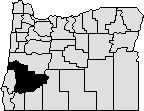
The early history of Douglas County is tied to Umpqua County. Umpqua County, created in 1851, was located along the Umpqua River in southwest Oregon. Gold was discovered there
resulting in a rapid increase in settlement of the new county. The first meeting of the Umpqua County Court was in Elkton in 1852; later the county government was moved to Green Valley and Yoncalla.
Because the population of Umpqua County rapidly increased and met the population requirements for a new county, a new county was created on Jan.
7, 1852, out of the portion of Umpqua County lying east of the Coast Range. It was named Douglas County to honor U. S. Senator Stephen A. Douglas of Illinois who was a congressional advocate for Oregon statehood.
Meanwhile, in Umpqua County the gold mining boom played out, and the population of the county decreased until finally in 1862 it was absorbed into Douglas County and ceased to exist. In 1856 the Camas Valley was annexed to Douglas County from Coos County and further boundary adjustments were made with Jackson and Lane Counties in 1915. Today, Douglas County covers 5,071 square miles and is bounded by Curry, Jackson, and Josephine Counties to the south; Klamath County to the east; Lane County to the north; and Coos County and the Pacific Ocean to the west.
In the county seat of Roseburg, courthouses were built in 1855, 1870, 1891
and 1929. The 1929 courthouse is still in use. The adjacent Douglas County Justice Building was constructed in the 1970s and houses county and state circuit court offices. Umpqua County never had a courthouse.
The first meeting of the Douglas County Commission was held at Winchester on April 4, 1853, with the three elected commissioners and sheriff in attendance. Winchester remained the county seat until 1854 when Deer Creek (renamed Roseburg in 1855) was made the seat by popular election. Douglas County had a county court form of government until 1965 when a board of commissioners was formed. Current elected officials include three commissioners, assessor, clerk, district attorney, sheriff, surveyor
and treasurer.
The county's population
increased steadily from 3,203 in 1860 to 108,850 in 2013, a rise of 1.1% over 2010.
The entire watershed of the Umpqua River lies in Douglas County. The heavily timbered county contains nearly 1.8 million acres of commercial forest lands and one of the oldest stands of old growth timber in the world. The forest products industry continues to play a significant economic role in the county. Agriculture, featuring mainly field crops, orchards, vineyards, and livestock, is also important to the economy. There is a significant federal presence in the region; the U.S. Forest Service and Bureau of Land Management administer more than 50% of the county's land.
The Umpqua Indians of the Umpqua Valley belonged to the Chinook tribe. Following the Rogue River Indian War in 1856, all remaining natives were moved by the government to the Siletz and Grande Ronde Indian Reservations.